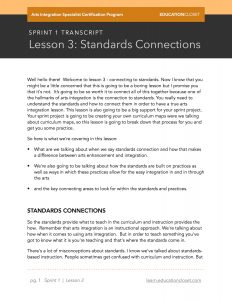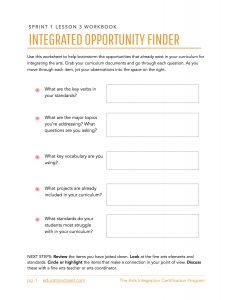SPRINT 1, LESSON 3
Connecting through Standards
Video play time: 13:28
One of the hallmarks of arts integration is the connection to standards. You really need to understand these connections in order to have a true arts integration lesson. This lesson is also going to be a big support for your sprint project, which is to create your own set of curriculum maps. So you’ll want to pay close attention for how to do that in this training.
Here is what we’re covering in this lesson:
- What are we talking about when we say standards connection and how that makes a difference between arts enhancement and integration.
- How the standards are built on practices as well as ways in which these practices allow for the easy integration in and in through the arts
- The key connecting areas to look for within the standards and practices.





Yes, Yes, a thousand times Yes! I am so grateful that you explained why Standards Based instruction is important to Arts Integration. You are so right; we talk about it a lot, but never really hear why, even in Arts Disciplines. “The standards serve as a navigational system.” To me, this is the most important sentence spoken in this lesson. Many other good things, but this is where I know things will begin. I also found it very valuable that in addition to focusing on standards you took us right to practices. Practice is where the connections are made. I’m pretty saturated right now, but excited. Susan, so much good stuff. I love the way you lay things out systematically and try not to overwhelm. Little bites – so important! Thank you!!
You’re so welcome, Karen. I love that you see these connections and how important they are. :)
Thank you! Our NYS and National Visual Arts standards can be an arduous task to manage, as they appear so overwhelming at a glance. But what part of Education are we truly permitted to glance over? Not very much! Standards are to be read, re-read, relected upon, responded to and connected over and over again. Finally….I am starting to feel more comfortable in evaluating the key learning I am being asked to connect with my young Art students. The vocabulary work in lesson 2 and 3 is making this understanding and process so much more comfortable. YES…LITTLE BITES…KAREN.
Wow! What a great light bulb moment! Amazing!!!
Great lesson
I look forward to seeing how this will come together.
I think I will have to use the following:
1. Cambridge Curricum Standards (used in Bermuda ??)
2. Your Nation arts Standards (not sure if we have any for drama & dance) I do believe we have standards for visual arts and music.
3. We have science and social studies.
It seems like a BIG monster to be attacked however, I am sure I am overthinking and it will come together.
It will come together. Let us know if you have specific questions. We are here to help!
This may have been mentioned, but where did the 4 arts practices come from? (Create, Perform/Present/Produce, Respond and Connect)
This is definitely helpful. Now I need to look at the Virginia SOLS with a different lens.
Hi Molly! Those 4 arts practices come from the National Arts Standards. When you look them up on the site https://nationalartsstandards.org you’ll find that each area has standards written under each corresponding practice.
Meanwhile back in Reno… Thank you for the link!
I love the “At a Glance” files of the standards. It makes it super easy to see how they are organized. It really helps me see how those practices are relevant to the standards.
Thank You!! Thank You!!
I am in such a better place in terms of understanding the language and how to connect the academic standards to the art standards.
This whole lesson has been such an eye opener and I know its going to make my work in the future easier.
Oh I’m so glad this lesson helped to gel some of these pieces for you, Lisa!
As I was downloading grade specific (4th for me) standards, I came across our state arts standards. They are pretty easy to follow since they include the 4 levels of art integration. There was another level for Media Arts. May I include this as well if there is a fit for my classroom situation?
Absolutely, Rhonda! Please feel free to use Media Arts if they’re applicable for you.
I teach vocal and general music to elementary-aged students and we use the National Core Art Standards. This school year we used Standard Based Grading-an online report card for the first time. It was very different. A learning curve for me. All music students receive a Standard Based Grade in performance, create and response. K-3 receive numbers grades and 4th-5th receive letter grades. I have a cool bulletin board about the music standards.
I like using the resources from our State Superintendent of Public Instruction Office. I am looking forward to the 1st Sprint Project.
Have you seen this free resource we did for SBG in the arts? https://educationcloset.com/2015/02/10/standards-based-grading-in-an-arts-integration-lesson/
It’s all about taking the time to really access students in the framework on specific lessons-standards. Assessing students using teacher thinking questions: How are the performing, did they create well or not, did they have difficulties responding and so on…
Also helps students become ownership of their individual learning.
I like the article.
Thanks!
This is exactly what I want to do with the staff at my school. I am getting a lot of blow back from the arts specialist about general education teachers teaching their standards and not truly understanding the content.
Oh yes – I had that too from an art teacher about the classroom teachers. And I was the music teacher at the time! You’ve got to understand the root of the issue with the arts specialists – they are scared that this will either a.) dilute their content or b.) be used to replace them. It’s a matter of acknowledging those fears and then sharing what true integration looks like. That it really makes them the MVPs of the school.
Excellent points here! There is so much fear with arts teachers. Helping them see that they are an important piece to the puzzle of this work is so important. They are the resource for the teachers who don’t understand the standards. They teach arts specific skills so that students can use those to connect to other content. Students can’t demonstrate what they know through an art form if they don’t have an understanding of the art form. The key word is “integrated.” Nothing exists in isolation anywhere on this planet. Thus, this work cannot happen without the links the arts teachers provide!!! This is obviously not a complete and thorough analysis of this concept…just some meandering thoughts to HEAR HEAR what Susan said!!
I agree with everything said and understand… or do I? I am still having troubles with connecting it to a curriculum that I have to follow in our district. How do I integrate art in a prescribed curriculum? Am I missing something?
Ah…prescribed curriculum. Do you have pacing guides? This is common with a lot of schools, still. Personally, I don’t like them because they operate under the assumption that teachers need to have a script in order to do a good job. They have their place, but I just don’t think they are of the best service to teachers or students.
That said – since you’re working within some constraints, here’s what I recommend: start by looking for the lessons in your curriculum that are ineffective or a pain to teach. The ones where it takes 3 lessons to teach a concept because students just don’t get it after the first 2 times. Those are the areas where arts integration would be a better fit and maximize the learning. Take out those old lessons and substitute in an arts integration lesson for that segment instead. This allows you to strategically use arts integration where it will do the most good without replacing your curriculum or turning it upside down to revamp it.
We go into way more detail about that in Sprint 2 – so stay tuned!
It is so nice to see that the way I prefer to teach is the more constructive and successful method. Unfortunately I am now dealing with an administration who seems to think that authentic literacy and STEM are individual classes and can be dealt with by using scripted curriculum and an added novel studies at the very end of the day, with students being divided by skill level. Any suggestions?
Working with administration that doesn’t seem to be on board can be tricky. There are two things that all administrators respond to though: seeing something work successfully in action and data. Can you plan an integrated lesson in your own classroom and invite administrators to come in and take a look? Or, could you do an integrated lesson and intentionally take some before and after data to show the difference that the integrated lesson made? That way, you could show administrators what this could look like and how it can positively impact student learning and achievement.
Here’s the thing to remember most: start small. Even just one lesson in your classroom makes a difference. Be strategic about it and include administrators whenever possible. They aren’t going to change their minds overnight. They need to see it lots of times and they themselves might be getting told what to do from their bosses. So keep doing what’s best for your students and documenting as you go!
Standards-based arts instructions engages students with each other..The students learn how to work in teams, gives them the responsibility of collaborative work, valuing the themselves and contributing made by each team member.
In our school district we use the”I can” statements as a target which is placed on your teaching board. I see students taking more ownership in their learning. correspond with responsive ideas, incorporates group input and peer collaboration.
Talking about making connections! LESSON2 certainly confirms some of my interests I connecting arts lessons with other content areas, especially with Science and Social Studies. If one explores current, and recurrent national and international news events, there appears to be a plethora of natural connections we can make when it comes to “making sense of solving problems” and persevering in finding practical solutions as with Math Anchor ,Practice#1; making an Arts connection by “stretching their understanding and skills through by exploring such as cultural and historical contexts (via writing civic dialogue, script writing, blogs, and dialogical journaling). With many post-racial era and Title IX issues circulating in public school and civic arenas, students need creative ways to have a voice through academic settings. I believe Arts Integration can afford this opportunity. Thanks Susan for giving us all such great start for getting this process started. Off to putting the work in.
This lesson was eye-opening for me. By looking closely at the content standards for my state, I was able to make connections that I didn’t even realize I could make! I also saw content standards that linked to art lessons that I’ve been wanting to explore for a while now. It’s also making me look closer at my own standards.
This is so great to hear!
Our standards changed last year and the state department started offering sets of PLO sessions to help arts teachers understand both the standards (the format is really different from before but align with the national standards) and how to effectively use them. For this year’s set of sessions we will meet twice online and three times face-to-face. I am a very late started to all of this (had planned on truly starting two weeks ago), but I see a lot of how school was for me (especially my elementary and junior high years) and what I have done more in the past and in PDs. Hopefully this will help guide me in the right direction–especially in this pressed for time place.